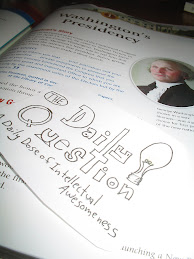I hope you are as excited as I am to be returning to the regular daily loop. Today's question is a bit of a cross-over question between science and music, so I did have a bit of turmoil coming down to the decision. As you can most certainly tell, I chose to put it under science. Since it was beautiful today, I decided to sit out on my sun porch and listen to music. And not just normally listening to music on a sissy iPod, I mean listening to music on the phonograph. If you've never listened to music on a record player before, you definitely should some time. Anyway, all this was brought on today when I was looking downstairs in my basement and found a container of jazz records. Well, you can bet I popped those guys in there as soon as I could get up the stairs. And as I watched the record spin tunes from the likes of Prima and Brubeck, I began to wonder how it was actually being brought to me. So for my daily question, I ask: How does a phonograph work?
There is an infinity of informational depth that you could get into on the subject of sound, and no one, me especially, likes hearing complexities that I couldn't care less about. So basically, a record is started with a sound. The sound travels down a tube, and makes a part called the diaphragm vibrate. The diaphragm is connected to a stylus, that then pushes down on the new record, at this point made out of wax. The record is on a platform being spun as the imprints are being made on it. Think of it as the childrens' song about bones: The sound is connected to the, diaphragm. The diaphragm's connected to the, stylus. The stylus is connected to the, record. This process makes a piece of wax with tiny little groves all over it. Now, do it in reverse. When you put the wax on a spinning platform, and let the stylus spin slowly down it, the sound is sent down a diaphragm, and out the horn. Then, a contented jazz enthusiast can obsorb the music.
For more info visit: http://www.pbs.org/weta/roughscience/series2/challenges/sound/page3.html
Welcome to The Daily Question, a blog dedicated to the advancements in modern random fact gathering. A new question will be posted everyday, about almost anything, so please check back soon. Also, feel free to check out the archives, which are full of more fun facts. Have fun!
Subscribe to:
Post Comments (Atom)











No comments:
Post a Comment